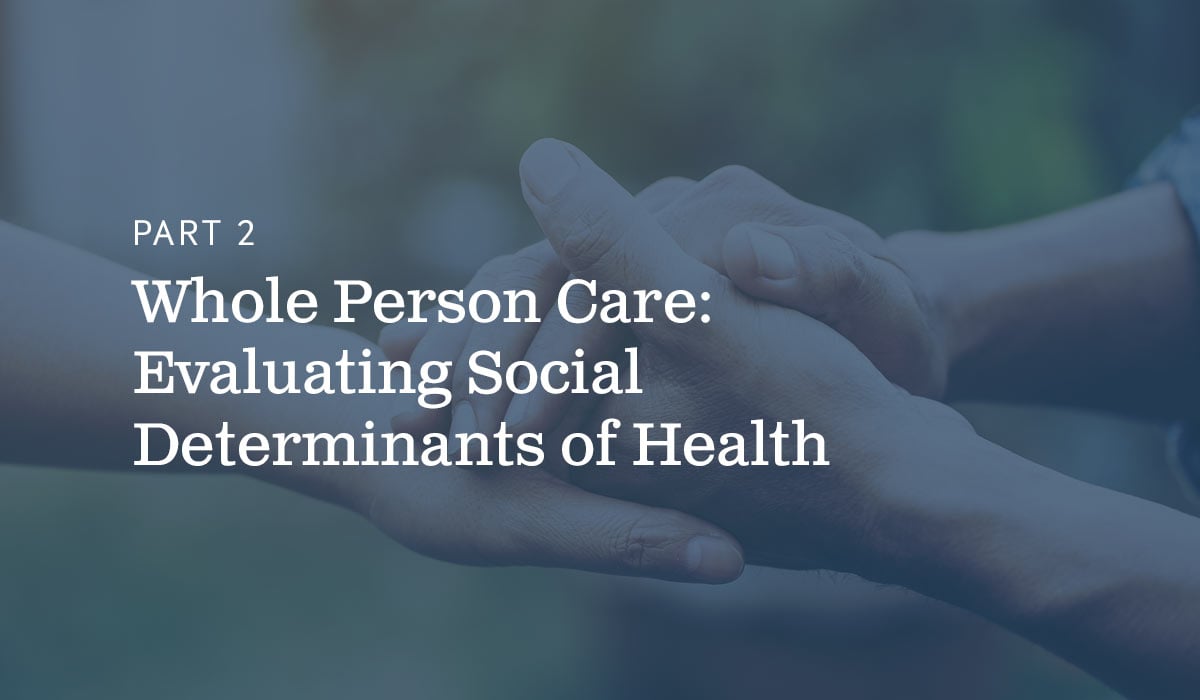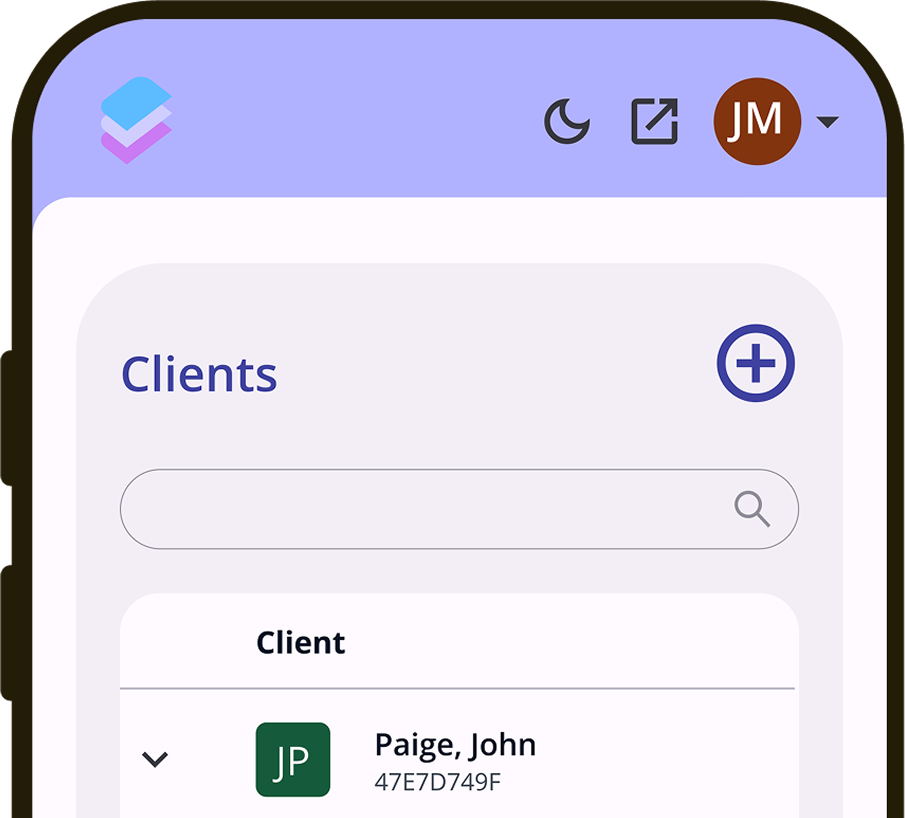Whole Person Care Part 2: Evaluating Social Determinants of Health Crucial to Providing Improved Patient Care

Too often care providers view patients as a list of symptoms that can be treated without much regard for the social context in which people live. Sadly, this is even true for individuals experiencing homelessness.
In a recent blog, we discussed how important whole person care is to case management. As a patient-centered human services approach, whole person care integrates a diverse range of resources to meet the behavioral, material, mental, and social needs of people in vulnerable circumstances. This comprehensive orientation is heavily informed by the social determinants of health (SDOH), which add context that is critical to understanding a patient’s needs, typically beginning with their housing status.
What Are Social Determinants of Health?
Social determinants of health (SDOH) are the non-medical factors that impact a person’s overall quality of life, such as the economic vitality of their neighborhood, access to grocery stores, or relationships with family members and friends.
According to the U.S. Department of Health and Human Services, SDOH can be divided into five categories: economic stability, education access and quality, health care access and quality, neighborhood and built environment, and social and community context. More specifically, these influences include safe housing, transportation, exposure to discrimination or violence, job prospects, income, opportunities for physical activity, polluted air and water, and language and literacy skills.
Each factor feeds into another and works in interlocking ways to either benefit or subvert a person’s ability to experience a high quality of life.
For example, Adverse Childhood Experiences (ACE), a blend of neglect, abuse, or trauma encountered while young, within a family or community, can create obstacles to overall well-being long into a person’s adulthood. These experiences in childhood can translate into difficulty forming meaningful relationships with peers or neighbors, which makes networking or getting a job more difficult, threatening a person’s ability to establish a steady income and, ultimately, secure housing.
Additionally, somebody may live in an economically depressed neighborhood, hindering their access to promising jobs or the educational opportunities that would improve their financial situation. This lack of resources then inhibits their ability to afford nutritious food, maintain a physically active lifestyle, and, once again, obtain long-term housing.
Homelessness, or unstable housing, is a significant SDOH. In fact, according to a 2017 article in the International Journal of Environmental Research and Public Health, people experiencing homelessness are predisposed to much worse health outcomes than their housed community members. This is due, largely in part, to poor material conditions and food insecurity.
Evaluating SDOH is about getting individuals care whose needs might not be evident at first interaction, and assisting caseworkers by giving them user-friendly tools and assessments to humanize the intake process.
Given the strong connection between other SDOH and housing, whole person care tends to focus on a housing-first approach. If care providers can center their efforts around assisting those experiencing homelessness, they can more effectively address challenges due to other SDOH.
However, to create a full, clear picture of the population experiencing homelessness, better prioritize needs, assess inventory, and implement policies based on a rigorous understanding of individuals’ SDOH, a CoC needs a powerful homeless management information system (HMIS).
Improved Patient Care Requires a Powerful HMIS
When treating the medical issues of a patient experiencing homelessness, it’s important, where possible, to acknowledge and address the other social dynamics active in their life. Given the impact patients experience due to SDOH, effective whole person care must have a well-integrated technological system capable of tracking each factor throughout a community, giving caregivers a comprehensive view of their patients’ social context.
For instance, if a patient experiencing homelessness shows up at a medical clinic, the care provider can better address their needs if they have access to tools and systems monitoring SDOH and how they impact a particular patient. A physician can provide superior help for a medical condition if they understand which economic, social, or psychological resources are available to a patient—made easily available through a dynamic HMIS.
Clarity Human Services HMIS
Clarity Human Services, created by Bitfocus, is a robust HMIS software with many capabilities crucial to providing care for those experiencing homelessness. It streamlines case management without forgetting the human faces involved—caseworkers, patients, and agency administrators alike.
It’s certainly challenging to select the proper HMIS vendor for your community, but here are just a few of Clarity’s features:
- Designed to give case managers tools they need to implement whole person care with customization and integration possibilities.
- Allows for straightforward data sharing while remaining compliant with sharing and privacy obligations.
- Includes an API to connect authorized applications with the HMIS, integrations with electronic health record (EHR) platforms, data warehouses, and others.
- Highly customizable program and service configuration functionality enable a flexible workflow for any program, including integrating non-HUD programs into the system and capturing unique workflows and performance metrics.
- Data field editor and screen designer tools facilitate the creation of custom assessments that support SDOH evaluations, ensuring you have fresh and reliable data.
- Administrators can use the Assessment Score Processor tool to create custom scoring and questionnaires that go beyond standard assessments like the VI-SPDAT.
- Includes native integration with the ArcGIS Online®—allowing geospatial integrations with other GIS platform users, and the overlay of geographic information onto mobile-accessible maps, including SDOH atlas data (see below).
- Features an extensive referral system enabling client referrals to programs that can address the diverse needs of each person.
On top of an innovative HMIS, an organization or continuum of care (CoC) can also benefit from other tools supportive in evaluating SDOH.
Evaluating Social Determinants of Health
Tools for evaluating SDOH can include measures, indices, and maps for any given community or locale. Let’s consider some of the most common instruments out there.
Community-Based Tools
Organizations and caregivers have a bevy of community-based tools available for evaluating the likely impact of SDOH.
The Neighborhood Atlas, created by the University of Wisconsin School of Medicine, freely shares data accounting for which neighborhoods are disadvantaged based on a variety of SDOH, such as socioeconomic disadvantage, which entails factors within the domains of income, education, employment, and housing quality.
Built by PolicyLink and the USC Equity Research Institute, the National Equity Atlas is a comprehensive tool for addressing racial inequalities. Its data includes demographic changes, potential economic growth gains, and racial and economic inclusion. Put simply, it measures the racial equity of any given community.
Developed by Opportunity Nation, the Opportunity Index provides an interactive database to reflect a variety of SDOH, such as economic, community, and educational factors.
The County Health Rankings and Roadmaps is another tool helping community leaders and caretakers to identify how social environments influence the overall quality of life for individuals in a given place or population.
Individual-Focused Tools
As the name suggests, social determinants of health are holistic and communal by nature. However, there are also more individual-focused tools available to help caregivers and case managers provide better support.
The Accountable Health Communities Health-Related Social Needs Screening Tool is a 10-item diagnostic used to help caretakers discern how well an individual is doing across the 5 major SDOH categories (economic stability, education access and quality, health care access and quality, neighborhood and built environment, and social and community context).
Produced by the National Association of Community Health Centers, the PRAPARE Protocol can be used to review an individual’s SDOH, specifically their personal assets, risks, and experiences.
Developed by the American Academy of Family Physicians, the EveryONE Project Social Needs Screening Tool gives care providers a short assessment for identifying SDOH. It can easily be used to develop a plan of action for a patient.
With this array of tools at their disposal, case managers and care providers have extensive information on SDOH that can be integrated into a powerful HMIS software, resulting in more positive outcomes for the most vulnerable members of their community.
Treating and Caring for the Whole Person
The goal of whole person care is to provide stability, not just short-term solutions to underlying problems that may compound. Powered by a well-integrated HMIS and coupled with vital tools for evaluating SDOH, your organization or CoC can be confident you’re in the best position to help marginalized and vulnerable populations within your community.
Ultimately, more people secure housing, care solutions are tailored to individual circumstances, and less stress is placed on communities at large and healthcare systems in particular. Most importantly, people are treated and appreciated as whole individuals.
Clarity Human Services is Bitfocus’ premier HMIS offering designed to empower communities looking for ways to improve their systems of care.
